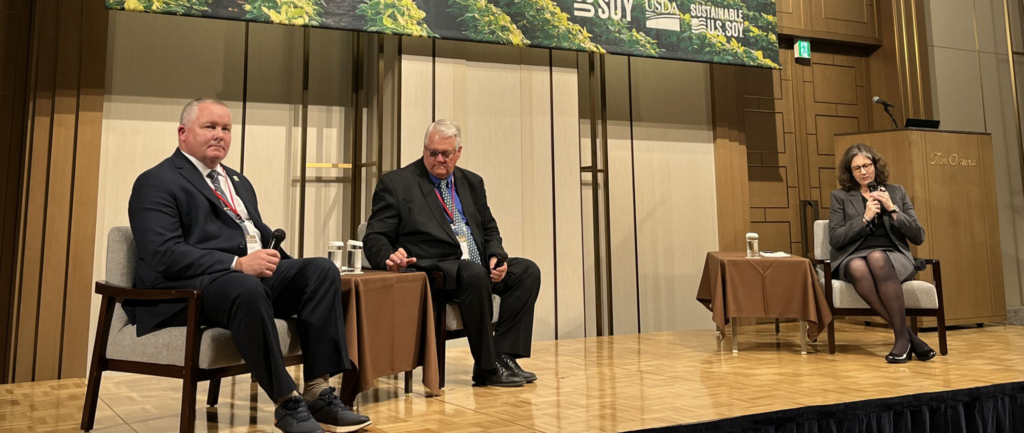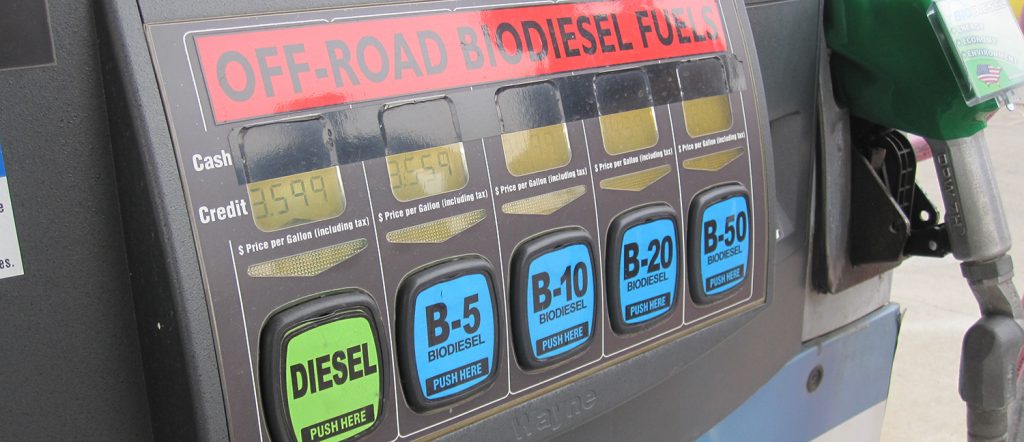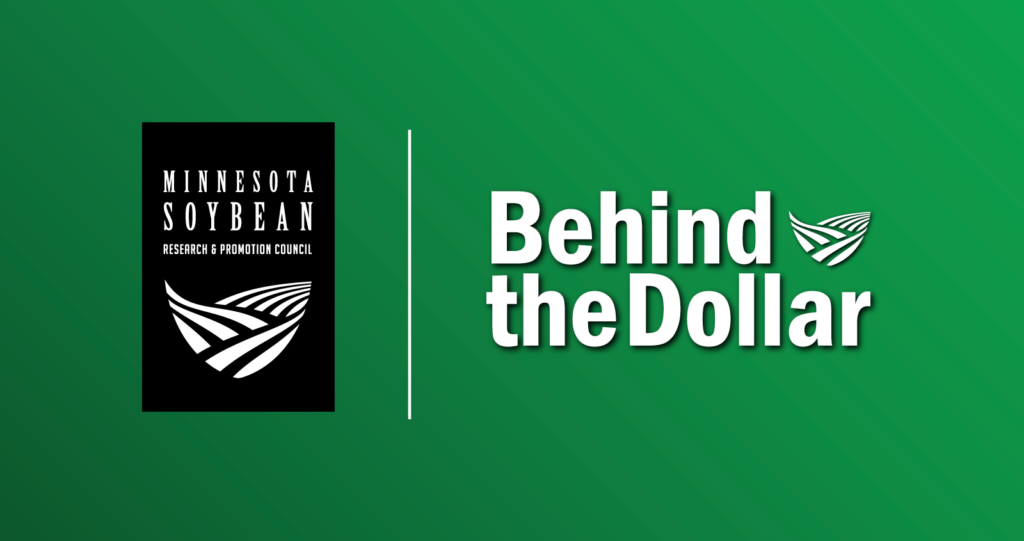A checkoff-centric Q&A with Minnesota Soybean Research & Promotion Council (MSR&PC) Vice Chair Gail Donkers.
Read below to learn more about Gail and the Council’s Behind the Dollar initiative.
This interview has been edited for length and clarity.
Q: Give us a quick background on your farm.
Gail Donkers: We have a multi-generational farm. We farm with my husband’s father, Paul Donkers, my brother in-law Matt and then our two sons, Mitch and Riley help on the farm as well. We run land in a big vicinity, but it also spreads out our risk. We also raise bottle calves to finish dairy steers, finish hogs and we also raise and sell purebred breeding stock for Babydoll and Dorset sheep.
Q: What region of the state do you represent on the Minnesota Soybean Research & Promotion Council? How long have you been on the board?
GD: I farm halfway between Kenyon and Faribault, and I am in District 8. I’m on my second term on the Council.
Q: Why did you decide to run for the Minnesota Soybean Research & Promotion Council?
GD: Keith Schrader talked to me several years before I actually ran for the Council, and he kind of told me about it. It’s something I was always curious about. You get your checks in from your payments, and a portion of money is taken out for the checkoff. I always wondered what happened to those dollars and where they went. So, this was a perfect way to find out more about it.
Q: Why do you feel the checkoff is critical to Minnesota’s soybean farmers?
GD: The checkoff is so critical, and I have to say, since I’ve gotten involved with MSR&PC I see that it’s so much more important than what I ever even thought it was. It’s such a great way for soybean producers to find new places to sell their soybeans, like the Uzbekistan project that we’ve been working on, and Morocco. It’s a great way to do research to do a better job of raising our soybeans. We have a whole team that works on research and working on new seed and best practices. We also have the education side where we educate people about soybeans.
Q: How does the board ensure checkoff dollars are invested responsibly?
GD: There is a chart that shows for every dollar soybean farmers invest into the checkoff, soybean farmers earn $12.34 in return value. Checkoff dollars really do make a difference and we are trying to make the best choices for making soybeans in Minnesota more profitable. We have a superior product compared to other soybeans across the United States. We need to showcase our soybeans and we need to tell people about how wonderful they are. Without that, we wouldn’t have nearly as many sales of soybeans and soybean meal and it’s just a very important thing that we need to embrace and to work harder on. We’re never resting at Minnesota Soybean. It’s always, what’s the next project?
Q: How has directing checkoff funds raised your awareness of the soy checkoff?
GD: Directing checkoff funds has raised my awareness tenfold. I’m just so much more aware of what’s going on with the checkoff dollars and how hard the Minnesota Soybean Research & Promotion Council tries to utilize the dollars wisely. When we go to our Requests for Proposals (RFPs), and we interview the people that are submitting the proposals, we find out what they’re doing and why they’re doing it and go very in depth into it. It’s very hard to decide which projects should get the checkoff dollars. As a team it’s very interesting to see the different ideas the farmers have in the room. What we’re trying to do is to maximize the profits for every soybean farmer in Minnesota, utilizing the checkoff dollars wisely and to put it towards new projects, new research and new education possibilities.
Q: What project(s) are you most proud of that you have seen since being on the board?
GD: The Ag Innovation Campus (AIC) pulled to the top quickly for something I’m most proud of. Despite a lot of obstacles we’ve faced, in the end, I think it’ll be a fabulous project and it will be a great resource for Minnesota. We’re the only ones in the nation that have something like the AIC, and I look forward to different organizations utilizing it to find out more and to test their products and to make new products and to do research. I think it’ll be a great thing for Minnesota to have.
My second favorite project I think, has to be the Uzbekistan project. It’s something that we’ve taken on as a Council. We really didn’t need to, but we’re trying to get soybeans into the country and nobody else wanted to help them and they needed soymeal. From that, we’ve really gotten a good relationship with Uzbekistan going. We’ve had people from Uzbekistan, come to Minnesota and tour and to learn more about what’s going on in Minnesota and raising soybeans here. We’ve also shipped soybeans to Uzbekistan, which is a difficult thing because it is a landlocked country.
Q: Many checkoff investments are made to impact our future growers. What are some checkoff-supported projects coming down the pipeline that you’re excited about?
GD: We’re looking at what the future of soy transportation is. That’s a huge factor in soybean marketing. As we get more crushing plants on the horizon here in the United States, we have more soybean meal that needs to get exported. With the change in our weather, our main route out is either the Mississippi River going south – and that has been a challenge the last few years with the drought – or we also have trains going west to the Grays Harbor that takes care of a lot of the northern soybeans. But what is going on out to the east? Last year we did a trip to Halifax, Nova Scotia. If you ship out of Duluth through the St. Lawrence Seaway, Halifax is basically the end of the line as far as the United States and it also has a huge port there that can really facilitate a lot of shipping.
We’re just looking down the pipeline as far as what our options are. Maybe not, this year or next year, but maybe in 20 years what should be or could be a better option for us. And then as we are growing our business out of the Duluth port as well, we have shipped soybeans to Morocco out of there. We’re taking another leap and going to Amsterdam to look at the port in Amsterdam and Brussels to see what the opportunities are in that area and what are some of the challenges that we need to figure out and how to overcome them.
Q: What do you think the biggest misconception other farmers have about the soy checkoff program? How would you respond to their concerns?
GD: I think probably the biggest misconception would be that the checkoff dollars are wasted. I don’t feel that is true at all. In Minnesota, especially, I think that we do an excellent job of being very conscious about how every dollar is spent. We are very cost efficient. It’s something that we as farmers do every day, but we carry what we do on the farm into what we do at Minnesota Soybean as well. We’re very cost conscious.
Q: Where can another farmer go to get more information on how their dollars are being spent?
GD: I would say invite your directors to come in and talk to your county soybean annual meetings and that type of thing and share what’s going on. Also, look up Mnsoybean.org and click on the MSR&PC side to find out what’s going on with the different checkoff dollar projects.






